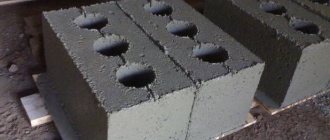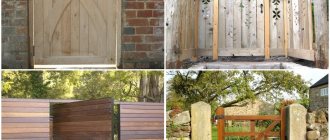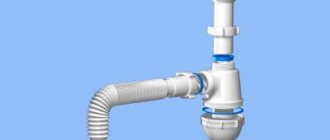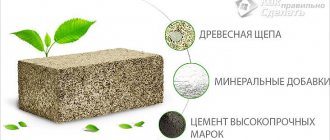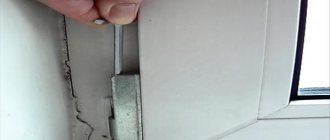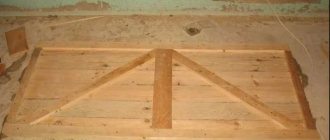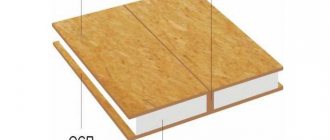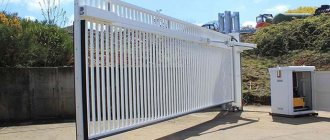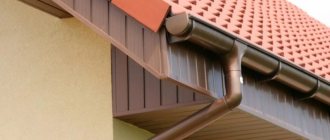When constructing a new building, the developer monitors one goal - to achieve maximum savings in money and at the same time provide the customer with a high-quality and durable project. To reduce the cost of materials in the construction industry, they began to practice the production of foam blocks. At a low cost, such material has a lot of operational advantages.
How to make foam concrete yourself
To create high-quality material, it is necessary to prepare special equipment and study manufacturing technology. It provides the following nuances:
- Only pure cement with a grade of at least 400 can be used as a starting raw material for the production of foam blocks at home.
- Foam is added only after thorough mixing of the main components.
- To check the quality of the final product, you need to take a small amount of the mixture into a bucket and turn it over: high-quality foam will not leak out.
- In a semi-hardened state, the concrete is removed from the molds and divided into small blocks. The optimal period after which the material is removed is 24 hours. After cutting, the blocks are dried on a pallet for 15 hours at a temperature above 5°C.
To make foam concrete with your own hands, you can use the following technologies and methods:
- Autoclave.
- Simple.
- Non-autoclave.
- Using a concrete mixer and a foam generator.
In most cases, home craftsmen create material without using a kiln. And although the production technology itself may seem quite simple and accessible, if certain rules are not followed, the final product will turn out to be of low quality and will not meet the stated operational requirements.
When starting production, you should correctly calculate the proportions of the components, choose the optimal time interval for kneading, drying and holding in molds. If these rules are followed, foam concrete will be reliable and durable.
DIY foam generator for foam concrete
Purchasing this module is the most expensive part of production.
The purpose is to convert the foaming agent into foam before feeding it into the solution.
The design of the foam generator consists of three components:
- feeding module. A foaming agent solution is poured into it. Any container can perform this function;
- converting module. The quintessence of the installation is foam conversion;
- dosing module. Provides the ability to supply foam to a solution of a given density (determined by the brand of foam block).
Diagram of a foam generator for the production of foam concrete
Diagram of the device of a foam generator for the production of foam concrete
To make a foam generator you will need: a metal pipe (2 blanks), a pump, hoses, valves. And also a welding machine. The components are listed in more detail in the specification that accompanies the drawing of the foam generator.
Assembling a foam generator for foam concrete (diagram-drawing)
Drawing of a foam generator for foam concrete
Making a foam generator
The specificity of the factory foam generator tube is that at first it has a narrow channel, which then widens. This technique allows you to increase the speed of passage of the emulsion through the tube. Then at the exit it will have the maximum possible speed.
How to make a foam generator for foam concrete with your own hands?
To do this, you need to make a turbulent mixing chamber and the main foam cartridge.
Making a mixing chamber
Weld two pipes to one of the prepared pipes. Moreover, it is advisable to place one of them (through which air will be supplied) at the end. And weld the second one, intended for supplying the foaming emulsion, on the side (at an angle of 90°).
Both inlet pipes (end and side) are equipped with two valves:
- shut-off (allowing you to shut off the flow of foam concentrate);
- adjustable (allowing you to adjust the supply parameters, change the pressure, pressure, quantity, etc.).
In practice, after the mixture supply parameters have been adjusted, the control valves are not used.
Note. The diameter of the side pipe should be 15-20% larger than the diameter of the end pipe.
Making a foam cartridge
A pipe is welded to the second pipe blank. It is designed to release the finished mixture. It is advisable to equip the outlet pipe with a device in the form of a funnel to reduce the rate of exit of the mixture. A filter is placed in the blank. The purpose of which is to convert emulsion into foam. You can purchase a ready-made filter.
But its function can be performed with no less success by metal mesh (brushes) for cleaning dishes.
At the same time, spiral ones are not suitable, only wire ones. These meshes need to be compacted as tightly as possible along the entire length of the foam cartridge pipe. To prevent mesh particles from flying out along with the mixture, a “Ruff” is installed at the outlet of the pipe, inside of which a mesh washer is installed.
Connection of mixing chamber and foam cartridge
Next you need to connect the mixing chamber and the foam cartridge. Naturally, this must be done so that the welded pipes are placed at opposite ends. To ensure an increase in the speed of passage of the foam concrete mixture through the tube, you need to install a Laval nozzle or a jet washer between them. Replacing the nozzle with a jet will reduce the efficiency of the design by 30-40%, by reducing the speed of passage of the mixture through it. However, it is cheaper, easier to install and can be used as a temporary option. The installation location of the nozzle or jet is shown in the diagram.
Diagram of a foam generator for foam concrete using a washer jet
Size ratio of foam generator for foam concrete (depth and inlet diameter)
Size ratio of foam generator for foam concrete
Connecting the compressor to the end pipe of the mixing chamber
Any compressor that provides a pressure of 6 atm is suitable for operation. Using a compressor with a receiver, pressure reducing valve and pressure gauge will allow you to regulate the pressure.
Material prepared for the website www.moydomik.net
Connecting the foam concentrate container to the side pipe of the mixing chamber
The container is installed on the floor, a hose is attached to it, through which the foaming emulsion (foaming agent plus water) will be supplied to the mixer by moving through the side pipe. Installing a small pump (an ordinary household “trickle”) will allow for a more efficient supply of foaming agent to the foam generator. However, in order to save money, the supply can also be organized by gravity.
A foaming agent for foam concrete made in such a simple way will cost much less than a purchased one. And the resulting foam will be in no way inferior to the foam obtained from a factory generator.
What you need to have for making
A number of materials and equipment should be prepared when starting production; You can make foam concrete yourself using:
- Concrete mixer. Its volume is determined by the needs of the client. For the implementation of private construction projects, a 300 liter unit is sufficient.
- Medium-fraction river sand, which does not contain any impurities.
- Cement mixture grade M400-M500. It is prohibited to replace it with any other components.
- Steam generator for foam concrete. Production can begin without this equipment, but its presence guarantees increased strength and reliability of the final product.
- Water.
- Containers for pouring the finished mixture. Construction stores offer ready-made forms for foam blocks and gas blocks.
- Foaming agent.
There are other components used in special cases. These include a coloring additive that allows you to create colored material for rooms without finishing. A hardener can also be added to the composition, which increases the resistance of foam concrete to negative temperatures, moisture and other negative factors.
Making foam concrete at home
Among the materials offered on the building raw materials market, foam blocks are especially popular, for the production of which special installations for the production of foam concrete are used. Many developers have become convinced of the advantages of using foam blocks. After all, the universal building material has a range of advantages. Having mastered the technology for producing building mixtures, it is not difficult to produce foam concrete at home using a conventional concrete mixer and auxiliary equipment. Let us dwell in detail on the nuances of the technology.
Independent production method
When creating foam concrete with your own hands at home, you should calculate the volume of the container where the finished mixture will be placed. Based on the result obtained, you should determine the quantity of all components - for every 0.5 m³, 100 liters of water and 200 kg of cement mixture with sifted sand are used.
First of all, sand and cement are placed in a concrete mixer. Then, using a special device and a foam concentrate, foam is created at a rate of 500 liters of foam per 1 m³. The cement mixture is diluted with water and mixed with foam.
Many foam systems are equipped with a pumping element that allows you to quickly and efficiently pump the mixture into the drum.
After placing the components in the container, they must be thoroughly mixed. To change the density, different amounts of foam are added to the composition. The solution is poured into the mold and dried. Then the dry blocks are taken out and left to dry for 24 hours.
Foam formers are sold in hardware stores or created with your own hands. For this purpose, 150 g of caustic soda, 1 kg of rosin and 60 g of wood glue are used. All substances are combined, heated, and then stirred until smooth. Before production, water is added to the solution.
You can make a mold for the block yourself using available materials. This stage requires increased accuracy and adherence to technology. Otherwise, the geometry of the blocks will be inaccurate. To prevent the solution from leaking out, it should be covered with plastic film. When one portion is removed, you can pour in the next one.
How to calculate the required amount of foam block for a house?
There are several ways to calculate the required amount of foam block. The most common are: independent calculation and the use of special calculators. You can easily find a foam concrete calculator on the Internet.
We will look at how you can carry out calculations without using the latter using the example of a building 3 meters high and 11*15 meters in size.
It looks like this:
- We calculate the perimeter: 11*2+15*2=52 meters;
- We calculate the area of all walls excluding partitions: 52*3=156 m2;
- We will use a block of size 625*250*300 and we will lay it at 300;
- We calculate the area of the block: 0.625*0.3=0.1875 m2;
- We get the number of blocks in pieces: 156/0.1875=832;
- Convert to cubes: block volume=0.625*0.3*0.25=0.0375 m3; 1/0.0375=26.6 pieces of blocks in one cube; 832/26.6=31.28 m3 will be needed.
Since experts advise purchasing (manufacturing) products with a small supply, we will need about 33-35 m3 of blocks.
Cost price
Ready-made store-bought blocks are much more expensive than homemade products. To prepare a cubic meter of quality material corresponding to the D600 brand, you should know what foam and aerated concrete is made from: The standard recipe is as follows:
- 200-250 kg of sand-cement mixture.
- 1.5 l of foam former.
- Water. Can be used from a centralized water supply. The main thing is to correctly calculate the proportions of foam concrete and water.
You should also take into account the cost of electrical energy that will be consumed by the equipment. They may vary depending on the region where the mini-production is located.
Thus, in Moscow, electricity is more expensive than in the Moscow region or remote regions. The bulk of the costs goes to the purchase of cement. At the same time, the volume of financial investments is determined by the type of equipment used.
Briefly about the features of the material, its advantages and disadvantages
Before considering the production of foam blocks at home, let's briefly get acquainted with the material and try to find out why it is so popular among future owners of buildings.
Let's use the table.
Block features, advantages and disadvantages:
| Strengths | |
| Main positive properties | Short description |
| The foam block has a relatively low thermal conductivity coefficient and this is an important plus. When constructing a building using this material, it will be possible to obtain a truly warm structure. At the same time, you can slightly reduce costs for insulation, and in the future - for heating. The minimum possible value is 0.07 W*mS, the maximum depends on the density of the products and can reach 0.4 W*mS. The wall thickness may not exceed 50 cm. |
| Depending on the purpose, it can be characterized by a density grade from D300 to D1200. The least dense products have a low thermal conductivity coefficient and are usually used as insulation material. Such a foam block is called thermal insulation. In low-rise construction, structural and thermal insulation material is most often used. It is denser than the above, but its thermal efficiency is somewhat reduced. Particularly dense material is used in the construction of load-bearing structures. Its density can reach 1200 (kg/m3). This material is called structural. |
| Strength grades correspond to the density values of the material. According to GOST, the minimum indicator is M1.0, and the maximum is M12.5. |
| The frost resistance grade can reach a value of 100 cycles - and this is quite competitive. Products used in the construction of external walls must meet an indicator of at least 25 cycles. |
| Foam concrete and products made from it are easy to process. Using a saw or hacksaw, the products can be easily cut, and using a grater they can be sanded. |
| As a rule, products are characterized by considerable dimensions, which helps to significantly speed up the construction process. |
| The price of the products is quite budgetary, which makes it affordable for most developers. |
| The composition does not contain harmful components. Below we can finally verify this. |
| Foam concrete is heat-resistant and does not burn. |
| The technology is quite simple and does not require significant investments, with the exception of large-scale factory production. |
| The foam block can protect against extraneous noise; its porous structure gives it high sound insulation ability. |
| Foam concrete is a “breathable” material. |
| Various types of products are made from foam concrete, this is not only a wall block, but also slabs, panels, u-blocks and much more. |
| Weak sides | |
| Property name | Description |
| It is prone to moisture absorption, it is about 15%. Unlike its main competitor - another representative of cellular concrete (aerated concrete), the indicator is slightly reduced due to the closed pore structure. However, despite this, the material needs protection. This applies to correctly executed exterior and interior decoration. |
| When transporting and using in construction, care should be taken, since the products are quite fragile and are susceptible to mechanical impact. |
| As is known, foam concrete has good resistance to compression and weak resistance to pull-out forces. When fixing objects, it is necessary to use specialized hardware. |
Stages of work
If you are interested in how to make foam concrete at home, you need to carefully study the technology for making foam blocks and find the optimal recipe. After this, you can perform the required actions step by step, strictly following the instructions.
Foam solution
Foam concrete technology involves the preparation of cement mortar. It is created in the same way as for traditional concrete. It is recommended to use products under the M400 or M500 brands as a cement mixture.
It is important to make sure that the sand is dry and does not contain unnecessary impurities or additives. To dilute the components, plain water from a centralized water supply system is used.
Foam is added to the finished solution. A foam generator is sold in every hardware store or made from improvised materials.
Pouring solution into molds
The next stage is to pour the prepared consistency into prepared forms. Before performing this action, the containers are lubricated with a special solution. Builders know 2 methods of how to make foam blocks with their own hands:
- Molding.
- Cutting.
The first technology involves pouring the solution into the workpieces. When it hardens, you can remove it from the mold and wait another couple of hours for final hardening. Using such a technique has a number of disadvantages. First of all, this is possible damage to the metal, and also deformation of the blocks during removal.
It is quite difficult to install structures with uneven geometry; they are of poor quality and not strong enough. However, the cutting method is more expensive because it requires the purchase of special equipment.
Cutting technology
The production of foam concrete blocks using cutting technology involves dividing the finished slab into several separate sections. Within 6-9 hours, the raw material acquires an optimal degree of strength and can be removed from the formwork. Then the prepared array is moved by a traverse to the cutting equipment, and the specialist begins the cutting process.
The advantage of this technique is the highest accuracy, since the permissible deviation does not exceed 1 mm. The cutting complex is equipped with a special screw for removing the top and twisted strings that cut the material. To obtain different block sizes, the specialist changes the position of the cutting strings. 1 cycle lasts for 5-7 minutes.
After the event is completed, the container with the blocks is placed in a place to dry. After 12-24 hours, depending on the effectiveness of drying, the foam block is removed from the pallet and moved to the storage location.
The technique has the following advantages:
- The geometry of the blocks is smooth and correct.
- The edges have no deviations.
- Any chips or irregularities are excluded.
The disadvantages include:
- Additional costs for purchasing equipment.
- If the concrete does not harden, it will be destroyed when cutting.
How to get foam blocks in ready-made forms
Before pouring foam concrete into special forms, they must be treated with a lubricant that does not contain oil. After the material has hardened, it simply needs to be removed. After this, the blocks are left on the pallet for several more hours.
Pouring foam concrete into special forms
This technological scheme has a number of significant disadvantages:
- there is a high probability of damage to the foam blocks during the extraction process;
- Form deformation may occur.
Cutting technology
To produce foam concrete, cutting technology can be used, for which it is necessary to purchase special equipment. This technique involves dividing a solid slab into separate blocks. But in order to obtain high-quality material, it is necessary to choose the right moment for cutting. If this is done too early or late, there is a risk of concrete failure.
Cutting foam concrete
The cutting method has many advantages:
- it turns out to obtain a material with ideal geometric parameters;
- the blocks have smooth edges;
- There are no chips or nervousness.
Recommendations from experts
Experts recommend adhering to some principles and requirements that will allow you to create high-quality material without errors and deviations:
- To make molds for future foam blocks, it is recommended to use plywood with a laminated coating or durable sheets of metal.
- Before placing the solution into the workpiece, it should be treated with the solution, and the structure itself should be covered with plastic film.
- Drying is carried out in a temperature range of +50…+60°C for 48 hours.
- The material can be removed from the mold only after it has completely dried.
- The finished block is kept on pallets for several hours. Only after this is it used for its intended purpose.
- You can start plastering the walls only 3-4 months after laying, since the blocks shrink.
- Before starting finishing work, you should clean the material from dirt and dust, and carefully prepare the surface for applying the layer.
Making foam concrete at home - general information
When planning the production of foam blocks at home, you should study what technological methods are used for production, understand how to properly prepare the cement-sand mortar, and also prepare the materials, tools and equipment necessary for the production of the foam concrete mixture. If you want to use self-made foam blocks for building a house, you need to know the properties and characteristics of the foam concrete material. Let's look at these points in more detail.
Foam concrete blocks are used in the construction of low-rise buildings
Equipment for the production of foam blocks
In order to make blocks with your own hands, you will have to purchase equipment. You will need:
- A steam generator capable of producing at least 200 liters per minute.
- Compressor installation.
- Mixer hopper. For beginning entrepreneurs, a unit with a power of 2.2 kW and a working volume of about 280 liters is sufficient.
- Mold for standard blocks 200x300x600mm.
- Auxiliary instruments: pressure gauges, pumps.
Equipment in the form of a ready-made kit can be purchased in special stores. You can also make equipment to order. The second method is much more expensive and is financially justified only when home production has reached full capacity.
When organizing production, you should equip a room for drying finished blocks. It is also important to take into account the total power consumption to ensure uninterrupted operation of the equipment.
What properties does high-quality foam concrete have?
Foam concrete is a popular building material with the following advantages:
- increased thermal insulation properties due to the cellular structure. Heating foam block buildings requires less expenditure, since they retain heat better;
- resistance to negative temperatures with subsequent thawing. The integrity of foam blocks is maintained throughout 40-50 deep freezing cycles;
The material is not afraid of chemical influences and resists precipitation well
- resistance to the effects of elevated temperatures caused by contact with open fire. In fire hazardous situations, the integrity of foam concrete structures is maintained;
- high noise insulation characteristics, which ensure comfortable indoor conditions. Material with a porous structure effectively absorbs external noise;
- breathability, helping to maintain comfortable humidity and air exchange. Microorganisms do not develop in a foam concrete room and colonies of fungi do not form.
No less important advantages of foam concrete also include:
- environmental cleanliness;
- low cost of self-production;
- ease of machining;
- increased dimensions of foam blocks;
- light weight of products.
Along with its advantages, even high-quality foam concrete has some disadvantages:
- increased hygroscopicity. Foam concrete walls need reliable protection;
- increased fragility. During transportation and laying, blocks should be protected from mechanical damage.
Despite the disadvantages, developers prefer foam concrete due to the serious advantages of the material.
Foam concrete and aerated concrete - do not confuse
On the domestic building materials market today you can purchase two artificial, porous building materials - aerated concrete and foam concrete (according to GOST 25485-89 Cellular concrete. Technical conditions. ). They are similar in composition because they are made using cement, sand, water and a blowing agent. Thanks to the last component, the material obtains a porous structure.
But many do not understand the difference between these materials, because they have many similar parameters. The difference mainly lies in the manufacturing technology of these building materials.
When making aerated concrete, aluminum powder is added to a dry mixture of cement and sand, after which the mixture is mixed well. Next, water is added to it. After which the aluminum powder reacts with the cement, resulting in the release of hydrogen and AL oxides. Hydrogen fills the concrete mixture with bubbles, the structure of which becomes cellular (bubbles can be large - 3 mm or more or small - 1 mm or less).
With low quality material, it has a non-uniform structure in height, which is reflected in many of its parameters. High-quality aerated concrete has a uniform structure and improved characteristics.
